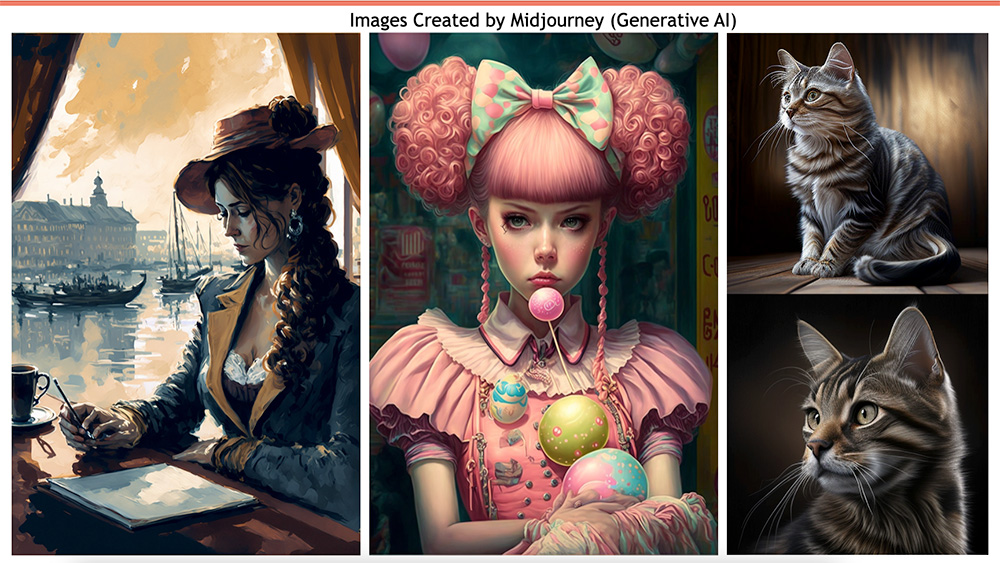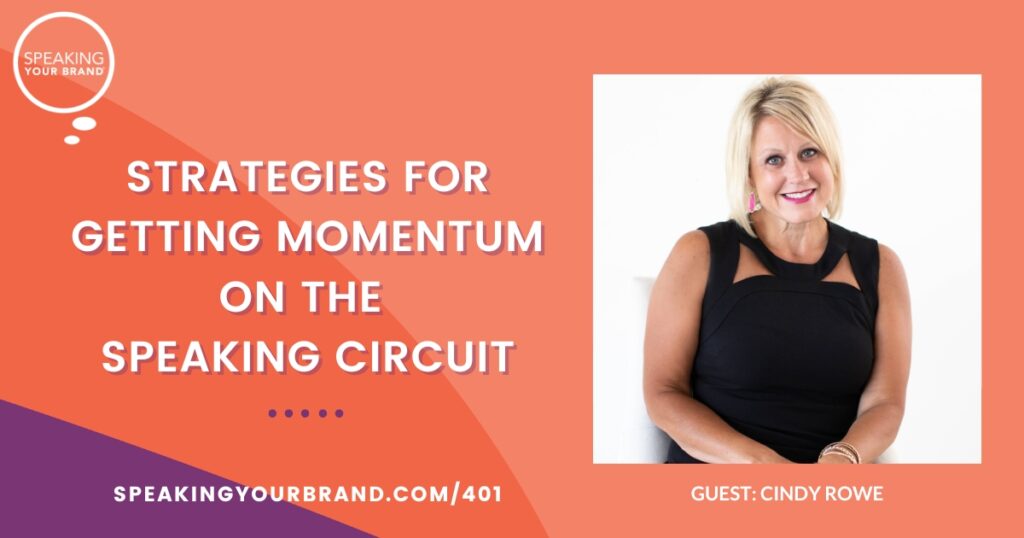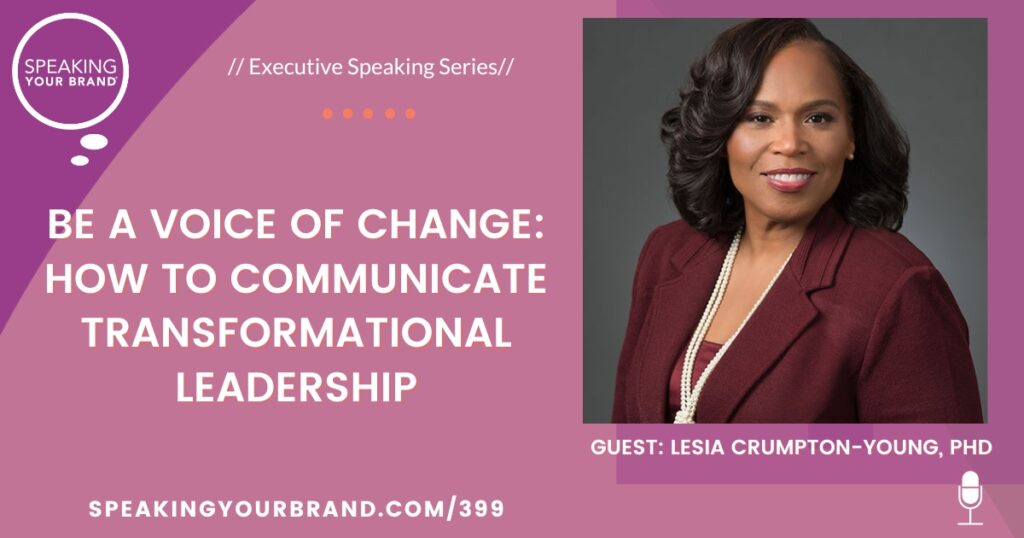Using ChatGPT and Image Generators to Enhance Your Content: Podcast Ep. 314

Subscribe to the podcast!
Get ready for a fun episode where I share how I’ve been using A.I. tools like ChatGPT and image generators like Midjourney and DALL-E.
You don’t have to be a techie or tech-savvy to start trying them out.
The key to thriving in the age of A.I. is to be proactive and adaptable. By embracing the technology, developing relevant skills, and staying informed, you can position yourself to take advantage of the many opportunities that A.I. has to offer.
This is the second episode in our new podcast series on A.I.
See More Examples of Images Created Using Midjourney (PDF)
About Us: The Speaking Your Brand podcast is hosted by Carol Cox. At Speaking Your Brand, we help women entrepreneurs and professionals clarify their brand message and story, create their signature talks, and develop their thought leadership platforms. Our mission is to get more women in positions of influence and power because it’s through women’s stories, voices, and visibility that we challenge the status quo and change existing systems. Check out our coaching programs at https://www.speakingyourbrand.com.
Links:
Show notes at https://www.speakingyourbrand.com/314
ChatGPT by OpenAI = https://chat.openai.com/
Ryan Reynolds’ Mint Mobile Ad using ChatGPT = https://youtu.be/_eHjifELI-k
Image Generators:
- DALL-E = https://openai.com/dall-e-2/
- Midjourney = https://midjourney.com/
- Stable Diffusion = https://huggingface.co/spaces/stabilityai/stable-diffusion
Discover your Speaker Archetype by taking our free quiz at https://www.speakingyourbrand.com/quiz/
Join our email list: https://www.speakingyourbrand.com/join/
Enroll in our Thought Leader Academy: https://www.speakingyourbrand.com/academy/
Connect on LinkedIn: https://www.linkedin.com/in/carolcox
Related Podcast Episodes:
- Episode 313: How to Thrive in the Age of A.I.
- Episode 310: Trends in Public Speaking and Thought Leadership for 2023
314-SYB-ChatGPT_and_Image_Generators.mp3: Audio automatically transcribed by Sonix
314-SYB-ChatGPT_and_Image_Generators.mp3: this mp3 audio file was automatically transcribed by Sonix with the best speech-to-text algorithms. This transcript may contain errors.
Carol Cox:
I’m sure in ways you can use AI tools like ChatGPT and image generators in this episode of the Speaking Your Brand podcast. More and more women are making an impact by starting businesses running for office and speaking up for what matters. With my background as a TV political analyst, entrepreneur and speaker, I interview and coach purpose driven women to shape their brands, grow their companies and become recognized as influencers in their field. This is speaking your brand, your place to learn how to persuasively communicate your message to your audience. Hi, and welcome to the Speaking Your Brand podcast. I’m your host, Carol Cox. We’re continuing this new series that I’m doing all about AI, artificial intelligence. It really kicked off with the Trends episode that I did at the beginning of January. That was number 310, where I talked about three trends that were going to be seen in 2023, the first one being the rise of AI tools, the second one being a huge shift that we’re going to be seen in online marketing. And the third trend was a resurgence of in-person activities. And the last episode I talked about how we can thrive in the age of AI. So how can we double down on being human for real? And I share three things that you can start doing now, because I know if you’re listening to this podcast, you want to share your message, you want to have an impact on more people, and you also want to grow your business.
Carol Cox:
And as online marketing changes, as our businesses and industries are going to change as a result, how can you adapt? And that’s really why I’m doing this series and I’m talking a lot about AI because I know what a transformation is going to have on all of us in 3 to 5 years from now. It is believed that the majority of the content that we interact with or create will be synthetically or artificially generated. And I’ve seen stats up to 90% of the content online will be synthetically or artificially generated. We’re not necessarily going to know what is real or who is real, which is why I feel like we need to double down on being human. Hence, last week’s episode we also need to learn to work with these AI tools, not pretend like they don’t exist or they’re not going to affect us. And you don’t have to be a techie or think of yourself as tech savvy to start trying them out, which is why I’m doing this episode. And at the end I’m going to share just a little bit of a sneak peek, a preview of something that we’re working on in the AI space that I’m really excited about. If you’re new here, thank you so much for joining us on the Speaking your Brand podcast. As speaking your brand, we empower women entrepreneurs and professionals to confidently and effectively communicate their unique brand message and story to a wider audience.
Carol Cox:
Our coaching and training services help our clients develop their thought leadership platforms and create compelling signature talks that inspire and influence others. We believe by amplifying the voices of women and increasing their visibility, we work towards disrupting the status quo and driving positive change in the world. If you like to learn about how we can work together, go to speaking in your brand dotcom. And by the way, that paragraph that I just read was a rewrite from our original kind of paragraph mission statement, and I fed that into GPT and it rewrote it like I just set it out loud. I think it did a pretty good job. Now let’s get on with the show. Let’s dive in now to look at some of these AI tools like ChatGPT and image generators. I’m going to share how we’ve been starting to experiment with them here at speaking your brand and give you some ideas of how you can do so as well. So these AI tools are what are called generative artificial intelligence. So that means that you give it a prompt, like a text prompt right now, and then the AI tool will come back and generate hence the word generative AI will generate text, images, sounds, video, audio, etc. in response to the prompts that you give it ChatGPT is an AI writing tool by open AI and as of right now it’s free to use. I believe they’re going to come out with a paid plan at some point, but right now it’s free to use.
Carol Cox:
There’s a link in the show notes where you can go and sign up for an account. And what these AI writing tools do is that they predict, literally predict what the next word in the sentence it thinks is going to be based on all of the data that it’s consumed and analyze from all the books, all the post articles, social media posts, podcast transcripts, everything, news articles, everything that’s been on the Internet. So when you ask it to do something, it’s just like a little text box prompt. It’s just a free form prompt and you go and you ask it to do something. You can ask it to rewrite something, you can ask it to create something brand new. And so you can ask it to write a blog post. You can ask it to write a blog post with bullet points. You can ask it to write an outline, an agenda for a workshop on a particular topic that you want to do. You can ask it to write an email, a poem. Song. Lyrics. Scientific Journal articles. News articles. Law briefs, video scripts, podcast scripts. Really just all these different types of formats. And what’s fun about it is that it knows what these different formats are. So it knows, say, for a video script is going to put in those little formatting things like person looks at camera or music sideways.
Carol Cox:
That’s the same thing for podcast transcripts or intro and the musical bridge. It actually puts those things in there so it understands different types of writing that you can ask it to do. You can also prompt it by asking for a certain style, so you can say write a poem in the style of Dr. Seuss, or write a poem in the style of Mary Oliver. You can ask it to write song lyrics in the style from Hamilton the musical or Chicago The musical. You can ask it to write something in the style of famous people. So obviously it knows a lot of the styles of well known things and famous people because they have a lot of writing, they have a lot of data on the internet, so you can ask it to write a speech in the style of John F Kennedy or in the style of Barack Obama. You can also prompt it by different types of sentiments so you can ask it to write in a professional style, in a serious style, or in a more of a fun style or exciting or silly. So you can just put these prompts in and then have it generate something for you. Now I always say this, this asterisked, this caveat is that it is well known that these that ChatGPT and these AI writing tools are not necessarily 100% factually accurate. So this is not like doing a search in Google and finding out something.
Carol Cox:
Google has done a better job over the years of trying to bring back factual information in the search results. ChatGPT is not like that because the AI is not looking for it’s not doing a database lookup, it’s not looking for a fact, it’s just predicting what word is going to come next and the sentence that it’s writing for you. And so that being said, that’s why it’s fun to to use ChatGPT to kind of write some of these things like blog posts and emails and poems. So and video scripts, podcast scripts and so on, and then go back obviously and edit it. Ryan Reynolds, the actor, has a really great video. It’s only a minute long. I included the link in the show notes where he used ChatGPT to write an advertisement for his company Mint Mobile, and so he put in these different prompts like he told it to make it funny, to include a curse word, to mention something in particular, which it did. So this certain phrase to include in there and he had a couple of other requirements in the prompts, and then he read it and it sounded pretty good. It sounded like him. And he said that it’s mildly terrifying but compelling. And I think that sums up so much of our experiences so far. Using these AI tools is, I guess, mildly terrifying and yet very compelling at the same time. Let me give you some examples of how we’ve been using ChatGPT.
Carol Cox:
I’ve been taking some of the emails that I write, so emails that I send to our Thought Leader Academy clients, emails that I send to the email list, even one on one emails, and I’m copying and pasting them, putting it into ChatGPT and asking it to rewrite it to make them sound more fun and exciting because I tend to be kind of a more professional business direct type of writer, and so it has been rewriting them to make them more fun and exciting. Now what I find hilarious about it is that sometimes it really obviously the voice that comes back with the style that it comes back with is not at all does not sound like me. So I would not necessarily use this, but it does give me ideas of things that I could use to rewrite the email. So for example, here’s the prompt that I gave it recently. I said, Can you please rewrite this email to make it sound more fun and exciting? And then I put in the email, This is for the Thought Leader Academy. So it came back and here’s how it started. The email that it rewrote it said, looking to join a crew of kickass purpose driven women Entrepreneurs want to surround yourself with a community of high achievers who are just as passionate about making a difference as you are. You’re in luck. Our Thought Leader Academy is starting next week and you don’t want to miss out.
Carol Cox:
And then it continues and goes on through it. And so then I said, okay, how would you describe the sentiment of the original email that I had put in? And it said that the sentiment of the original email is informative and professional. The information is presented in a clear and straightforward manner, so it basically nailed the original sentiment. But you can tell that its version of fun and exciting maybe not, not quite fit for me, but it’s done a better job of some other emails that I’ve had to put in. The other thing that I have asked it to do is to write some sales email, so I give it a little bit of information about whatever it is that I want to include in that sales email and I ask it to write a longer version of that and it does it. And again, some of the language is is more useful than others. But every single time I ask it to write a sales email, it always includes the phrase take your business to the next level. At least once, sometimes twice in the same email. Take your business to the next level. What this tells me is that millions of us online apparently use that phrase Take your business to the next level and everything that we’re selling because that’s what associates with sales emails. So I find that hilarious. Other things that I’ve used ChatGPT for is to write a poem to welcome new members to our Thought Leader Academy.
Carol Cox:
So I actually gave it a little bit of information. I said, the thought Leader Academy is for women entrepreneurs who want to use their voice to make an impact. And then I wrote actually a really lovely poem that I did send out to our new members and the Thought Leader Academy. And then I do indicate on that poem, for example, that I sent out that that was generated with the assistance of ChatGPT, because I want to make sure that I’m being transparent about using something like that, especially something wholesale, where really was just that was entirely generated by, by the program. The other thing that I’ve been using ChatGPT for is to brainstorm ideas, So it’s really good you can ask it what are five ideas for podcast episodes around, whatever the topic is and it will generate ideas for you. We had it generate ideas for props that we could use on stage and actually came up with some pretty some cool ones, some ones that you would already guess, but then some good ones, new ones as well. So ideas for props. You could do ideal ideas for blog post, all different things that will help you brainstorm. The other thing that I’ve tried it for is case studies. So I gave it a little bit of information. I copied, pasted a testimonial from one of our Thought Leader Academy clients, so I pasted it into ChatGPT and I said, Can you write a case study around this? And actually did.
Carol Cox:
It filled in a lot of information that was true about what the testimonial was saying, but it kind of put it into a case study format that is a huge timesaver because then I didn’t have to go write the case study from scratch myself. It understood what the format was and when it took the the tidbits from the testimonial and put it into that case study. So that was really helpful. The other thing that I’ve been having fun using ChatGPT for is to write stories. So I’ll say, Can you write a story about a young girl who gets lost in the library and discovers her love of books? And so then it starts once upon a time. I think it does that on purpose because I told it to write a story. Once upon a time there was a girl named Alice, of course, and the girl’s name always seems to be Alice, even though I didn’t specify that probably because of Alice in Wonderland. And it goes through and it’s a lovely story. It’s like a story that would be fit for like a later elementary school age, early middle school age person reading it. But it’s really lovely. And then I can go through and I can in the same chat thread, say, Thank you so much for the story. I’m very polite, by the way, to the AI tools.
Carol Cox:
I always say please and thank you because hey, you never know. And so I say, thank you so much for this. Can you please add some dialogue to the story? Because initially the story may be just kind of what’s going on, but there’s no dialogue in it. But what makes stories great is dialogue. So ask it to put in some dialogue and it goes back and rewrites. That story keeps keeps what it had done before and inserts some dialogue in it, and it does a really good job. The other thing that you can do is go through and if you say have it, write a blog post for you, then you can have it. Go and do bullet points for that blog post. Or you could have it do an outline or like I mentioned, an agenda for a workshop, whatever your topic is, and actually comes up with some really good, good information there. So I really see it as enhancing the work that we’re doing. That’s why I called this podcast episode how we can use these tools to enhance our content. Now, I’m not necessarily going to go and just have it generate a whole bunch of SEO kind of clickbait articles. That’s not what I want to use it for. We’ve seen in the news recently CNET apparently started doing that last year and now has been called out because the articles that the I wrote were not factually accurate. And again, that’s the limitation of ChatGPT but it is really good for doing things like brainstorm and ideas, rewriting content in a certain sentiment, doing, like I said, those case studies, poems, song lyrics, stories.
Carol Cox:
So have fun doing that. So those are the writing tools. Now there’s also AI image generators that will create images and graphics, ones like Midjourney, DALL-E and Stable Diffusion of those three <idjourney I feel like has the highest quality images that get generated. They are absolutely incredible, very detailed, high quality, really creative, really imaginative. If you go to the show notes for this episode, which is that speaking your brand dot com slash 314 so the episode number speaking your brand dot com slash 314. I’ve included some examples on the page of some of these images so you can see them. They really are truly stunning so many of them. So what you can do when you go into these image generator. You can give it text prompts so you can tell it what you want in the image that is creating. Do you want a person, a man, woman, child? Do you want a certain type of animal like a cat or a dog or a wolf or a zebra or a lion? Do you want it to be a landscape type of image? Do you want it to be a cityscape? Do you want buildings in it? You can also indicate what items you want in it. So maybe you want a person holding an umbrella who standing in front of a lake with a lion nearby.
Carol Cox:
I don’t know. You can just give it all these different things. You can have it put chairs or lollipops or cars, whatever you want. You give it all that detail or as much or as little detail as you want. And then you also can indicate the style that you want the image to come back in. So some of the terms that you can use are things like hyper realistic, photorealistic impressionist, cubist portrait, Renaissance, black and white photography. And so it understands what all those styles are and will come back in that style. You can also use specific artist names in it, but I don’t recommend this because there are now lawsuits against these image generators because they have basically scraped the Internet and gotten all of these images, many of which are copy ridden by the original artist. And so, of course, those artists, understandably so, did not consent to this and do not like that someone can come in and just use their name as a prompt, and then it will generate imagery that looks just like what they create. I mean, it’s it’s unbelievable how accurate it is. So yes. So some of these image generators are getting sued for that. And I totally understand where these artists are coming from. What they have said on a podcast that I listened to recently, one of the women, she’s a cartoonist named Sarah Anderson, and she’s part of the lawsuit.
Carol Cox:
Is that what they really want are the three CS? And yes, like so warmed my heart that she had her framework and she called it the three CS. What they want is consent. So they want to be able to opt in for their imagery, their creations to be in these image generator. So they want consent. Then they and if they do consent, then they want credit and they want compensation. Again, totally agree with that. Now one of the things that maybe we can call it a downside or and then eventually hopefully an opportunity is that the images of women that it tends to create do tend to be very sexualized. And that is even without putting any type of wording like that into the prompt, you can see that because that’s what’s on the Internet. Those are the images that are found on the Internet related to women. And I mentioned this in that Trends episode about the Lens app, which everyone was using late 2020 to where you would upload about 20 photos of yourself. And then it would create these kind of really beautiful images of you based on that. And what women were finding was that it was creating kind of sexualized versions of themselves without them asking for it. They didn’t indicate that that’s what they wanted back. And the lens spokesperson basically said, Well, that’s what’s on the Internet. That’s what our data has been trained on. So that’s what they’re getting back.
Carol Cox:
Again, I don’t I don’t think that’s a good enough reason. I think we need to put some some guardrails around that. So just just to be on the lookout for that. And so all of this being said that this is so much in flux. This is why I find this field so exciting, because we don’t know what it’s going to look like six months from now, a year from now, much less 3 to 5 years from now. You know, some of these lawsuits are going to be sorted out and and for good. I’m glad that these these issues are being talked about. So we here speaking your brand, are working on our own AI app, and I’m not quite ready to release the details of it, but definitely stay tuned to learn more because one of the things is that we want to make sure that women’s voices, writings, speeches, perspectives, experiences and stories are getting enough weight when we’re asking, especially text prompts, to give us back writings. Right now, these writing tools like GPT, because they’ve been trained on basically most of the Internet and all of the books that have been published. We know that there have just been more books published by men than by women. More men are media figures, our politicians, our speakers, our public figures. So, so much of of their writing and news stories about them is what is on the Internet. And we want to make sure that women are getting equal weight.
Carol Cox:
So if you would like to make sure that, you know, as we release updates related to the app that we’re working on, the best thing to do is to get on our email list. If you’re not already, you can do so very easily by going to speaking your brand dot com slash join again that speaking your brand dot com slash join and really I believe that the key to thriving in this age of AI that we’re going into is to be proactive and adaptable really embracing the technology, playing with it, experimenting with it, trying. About staying informed so that you can really position yourself to take advantage of the opportunities that I is going to have to offer to us no matter what our business and what our industry is. I hope you enjoyed this episode and that encouraged you to try out ChatGPT and these image generators. Again, links are in the show notes to all of these so that you can go create your accounts there. We’re going to be continuing this series on AI with interviews with women about how AI is affecting the industries they work in. So definitely make sure to hit, subscribe or follow in your podcast app so you don’t miss those upcoming episodes. And if you haven’t yet, listen to last week’s episode and the trends episode, definitely go back and listen to those as well. Until next time, thanks for listening!
Sonix is the world’s most advanced automated transcription, translation, and subtitling platform. Fast, accurate, and affordable.
Automatically convert your mp3 files to text (txt file), Microsoft Word (docx file), and SubRip Subtitle (srt file) in minutes.
Sonix has many features that you’d love including enterprise-grade admin tools, advanced search, secure transcription and file storage, upload many different filetypes, and easily transcribe your Zoom meetings. Try Sonix for free today.






![Why Introverts Make Great Speakers and Leaders [Executive Speaking Series] Host Carol Cox: Podcast Ep. 400 Why Introverts Make Great Speakers and Leaders [Executive Speaking Series] Host Carol Cox: Podcast Ep. 400](https://www.speakingyourbrand.com/wp-content/uploads/2024/07/SYB-Solo2-LinkedIn-1200x630-1-1024x538.jpg)
